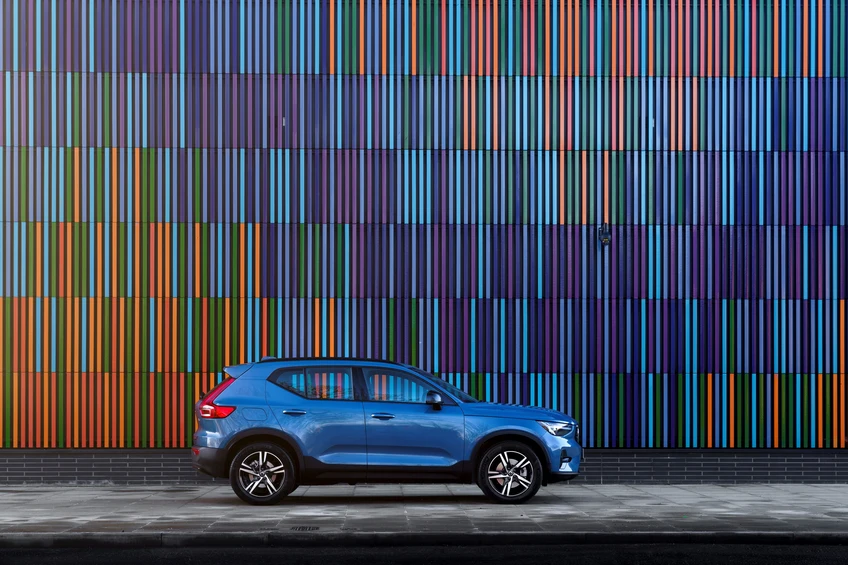Top 5 Small SUVs to Consider in 2024: A Complete Brochure Breakdown

Volvo XC40
The UK’s affinity towards small SUVs isn’t quite a headline anymore. The segment has seen steady growth since its inception, and pretty much every manufacturer is jumping on the bandwagon. In January this year, the top 3 best-selling cars in the country were small SUVs, which might give you an idea of what we are getting at. This would also explain our itch to give you the top 5 recommendations of models you should consider. So read on till the end because there’s plenty to talk about.
5. BMW X1
The X1 stands as the entry-point to BMW’s SUV lineup. It is primarily based on the 1-series but with a little more to offer. Compared to the outgoing version, the new X1 packs more space and has grown in terms of dimensions. The boot capacity at 476 liters (seats up) supersedes its rivals in the segment along with the overall dimensions as well.
In terms of engine options, the X1 gets a handful of engine options that cater to a varied spectrum of drivers. The options spread out to petrol, diesel, and hybrid options, but only with automatic transmission. Which we do not think is a deal-breaker. The xLine trim which kicks off the options has seven engine options including the 20i, 23i, 18d, 23d, 30e, and two variations of the 25e. There’s also a wild card in the lineup in the form of a 2.0-litre petrol engine that puts out 300 ponies in the M35i trim, you know, for the fun kind of people.
Interior quality and features have not been a pain-point for BMW in the past, and the X1 continues to promise the same idea. The car sports a healthy amount of soft-touch surfaces for all the major touchpoints along with smooth leatherette or leather on the steering wheel. You also get an option to choose between sporty or comfort seats.
The panel on the dashboard houses two large displays – a 10.7-inch infotainment touchscreen and a 10.25-inch driver’s display. BMW has made leaps in terms of user experience considering how easy to use the touchscreens are. While it might be subjective, we are not excited about the fact that there are no buttons for the infotainment system which means you will have to be actively involved to operate it. Talk about distraction, right? Other notable bits come in the form of a Harman Kardon sound system and the Driving Assistant pack.
4. 2024 Dacia Duster
The 2024 Dacia Duster was announced in November last year with some radical changes that raised our eyebrows. The car was revealed in new skin and some major mechanical changes. This complete overhaul, as claimed by Dacia, is touted to be the “best bargain on the market”.
The MY2024 Duster departs from the B0 platform that has underpinned every one of its predecessors since 2009. In is the CMF-B platform that is employed on cars like the Dacia Sandero, Renault Clio, and Nissan Juke. All winners for different things. Dacia claimed that the move was to benefit a few crucial aspects including practicality, refinement, and dynamics without taking a hit on its compact dimensions. Additionally, the new platform gives leeway for hybrid and mild-hybrid powertrains tagged along with a petrol option.
Dacia has dropped the 88-bhp three-cylinder turbo petrol for the 99-bhp four-cylinder engine as the car’s entry point. This engine is capable of running on both LPG and petrol. Meanwhile, the mild-hybrid powertrain comes in the form of a 1.2-litre turbo petrol three-cylinder engine that runs in tandem with a 48V electric motor and a 0.9kWh battery. Interestingly, this is also the only one available with a four-wheel-drive system.
The spotlight, however, will be on the Hybrid 140 powertrain which makes use of a naturally-aspirated 1.6-litre petrol engine with two electric motors combining the output that’s rated at 138bhp. Not surprising to know that Dacia has dropped its diesel engine.
On the inside, the design ethos remains the same with sharp clear lines rather than soft and rounded shapes. The contrasting color palette on the dashboard and the chunky steering wheel screams durability, like we have been seeing in the previous versions.
In terms of practicality, the boot space has gone up from 445 litres to 472 liters ranking higher than its rivals Ford Puma (456 liters) and Skoda Kamiq (400 liters). Credits for this go to the bigger dimensions this time around, rather than trick packaging.
3. Smart #1
We all know Smart, the company responsible for the tiniest EVs on the road. Well, the ownership of the company is now shared between Mercedes-Benz and Chinese titan Geely. For those who are coming across the car for the first time, it is called the hashtag-one and not number-one. The joint ownership between the two companies means that it was designed in Germany but manufactured in China. You and I can both agree that looks are subjective, but a good look at the rear of the car will definitely remind you of the EQB but in compact packaging. The overall design language is quite fluidic with curves throughout and minimal edges. The company aims this is purely for aerodynamics and maximizing fuel efficiency. So much that even the 19-inch wheels were built around it.
The Smart #1 is an EV. This means there is a lot more room inside the cabin, thanks to the missing transmission tunnel. However, one should note that the boot size of the car is a few rungs below the options we have discussed so far with a maximum of 323 liters with the seats up and 986 liters with the seats down.
On the inside, the #1 sticks with the textbook EV language with a minimalist touch. The lines are clean and uncluttered, and dominating the dash is a 12.8-inch touchscreen infotainment display with a load of features. The Smart #1 gets Android Auto and Apple CarPlay and if that doesn’t impress you, there’s also a voice assistant that handles a range of in-car functionalities. Pulling up your windows, reducing the temperature, or the volume of your song, everything can be done with the touch of a button.
At the heart of it, or should I say on the floor, is a 62kWh battery that runs its juice to a single electric motor at the rear wheels. Performance figures are rated at 272hp and 343Nm of torque. All three trims of the car deploy the same battery, with the Pro+ getting the highest mileage at 260 miles.
2. Ford Puma
The Ford Puma comfortably took the top spot in car sales in 2023, and the trend continued in the first month of 2024 as well. Before the arrival of its electric version, Ford has decided to give it a refresh. In the cards are a few subtle exterior tweaks and massive cabin overhaul with improved levels of tech trickeries.
The company has managed to contain the price surge at just 150 GBP, which we would say is commendable. Considering that Ford recently decided to pull the plug on its popular Fiesta, sales of the Puma might see some ripple effects. The car will now have to appeal to buyers of Fiesta’s prime rivals like the Vauxhall Corsa and Toyota Yaris.
Coming on the notable updates, Ford has shelled out plenty of cash on the inside. The cabin now feels much more premium than before with an all-new dashboard layout with a wraparound effect, slim-line air vents, and a new two-spoke steering wheel design.
Unfortunately, Ford has joined several other manufacturers in deleting all buttons from the dash for a cleaner and uncluttered look. This means most of the car’s functionalities, like the Smart #1, can be handled on the new 12.8-inch touchscreen infotainment system. The system runs Ford’s SYNC 4 software, a rung up from the current Puma’s SYNC 3 setup. Other notable bits that expand the list of features are ambient lighting, an acoustic laminated windscreen, an optional panoramic glass roof, and synthetic-leather upholstery on the seats, steering wheel, and armrest – with different colors of stitching, depending on the trim level.
Ford has implied a rejig in terms of the car’s engine options as well. The primary option comes as a 1.0-litre three-cylinder EcoBoost petrol engine available within two states of tune. Buyers can choose between the NA 123hp option or the 153-bhp mild-hybrid option assisted by a 48-volt starter generator. There’s a bit of thinning at the top level too. The popular Puma ST will lose out on its 197-bhp 1.5-litre engine and its manual transmission alongside. Replacing it will be the 168-bhp mild-hybrid version of the 1.0-litre EcoBoost engine paired with a seven-speed DCT.
1. Volvo XC40
The XC40 has not failed to impress us and deservingly sits at the top of this list. The XC40 was introduced on a rung below the XC60, competing against the likes of BMW X1 and Audi Q2 among others. Unlike the offerings in its segment, the XC40 doesn’t just look like a scaled-down version of its elder siblings, but with a distinct personality. The Scandinavian signature elements run inside and out with a minimalist approach.
The car scores decently in terms of practicality. In terms of boot capacity, the XC40 slots in between the BMW X1 and the Audi Q3 at 452 liters. However, the car does without a load lip, and the opening is nice and wide, saving an unexpected visit for a bad back. With the seats folded, this capacity goes up to 1,328 liters.
On the inside, the car continues to ship the 9.0-inch touchscreen infotainment system placed vertically. Upholstery in the car ranges from textile in the entry-level Core and the mid-spec Plus modes. Meanwhile, the Ultimate trims get part-textile, part-microtech.
In terms of powertrain options, the car comes with a 2-litre petrol engine in two states of tune outputting 163bhp and 197bhp. Both the engines are paired with an automatic transmission.
Summary
In conclusion, the small SUV segment in the UK is robust and shows no signs of slowing down, with a plethora of models catering to various consumer needs and preferences. From the BMW X1’s spaciousness and engine diversity to the 2024 Dacia Duster’s practicality and hybrid options, there’s something for everyone. The Smart #1, Ford Puma, and Volvo XC40 also offer compelling choices, showcasing advanced technology and design innovation.
The fact that the top-selling cars in January were small SUVs underscores their popularity and relevance in the market. As consumers continue to prioritize factors like fuel efficiency, technology, and versatility, these top recommendations serve as a valuable starting point for those in search of their next vehicle. With such a diverse array of options available, the small SUV segment remains vibrant and dynamic, providing ample opportunities for consumers to find the perfect fit for their lifestyle and needs.




